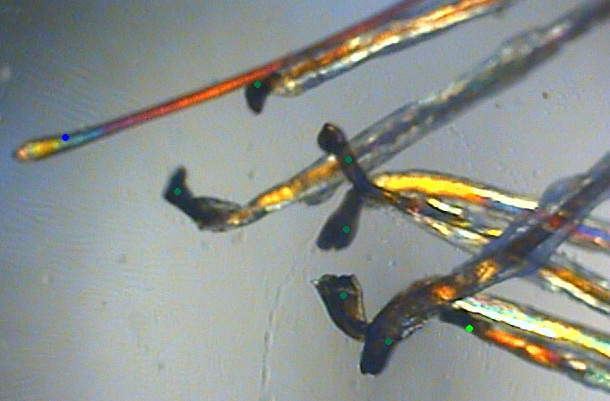
Trichogram is a semi invasive method used to estimate hair roots and hair growth phase relations. Morphometric evaluation of hair the subject was given by Scott in 1957, the term of "Trichogram" was introduced by V. Pecoraro in 1964.
Before conduction of the Trichogram hair should not be washed for 5 days. By means of a clamp or forceps with jaws protected by rubber tubes, 20-80 hairs shall be depilated from two standard zones. With an evidence of Alopecia Androgenetica, Telogen Alopecia, Anagen Alopecia syndrome, hairs shall be depilated from the point, which is at a distance of 2 cm from the front and 2 cm from the median line of the head, while the second point to be used is located at 2 cm lateral to the occiput. With Alopecia Areata hairs shall be depilated from the shattered hair area for the first point, while the second point of use is the intact contralateral side of the zone.
Clamp is applied to hairs about 0.5 cm above the surface of the skcalp. Hairs are being removed with a fast movement while observing direction of their growth. Hair roots are fixed on a glass slide with cover glass or on a transparent adhesive tape and examined under a microscope at low magnification. Trichoscopes-Dermatoscopes are being used quite often in clinical practice for hair roots studiesl. The subject of the Trichogram is to evaluate the percentage of Anagen, Telogen and Catagen hairs, as well as to determine any dystrophic and dysplastic changes in hair roots. Dysplastic hairs are deformed and smaller in diameter with a root shell completely or partially missing. Dystrophic hairs have disupted bulb, the hair shaft narrows conically, root sheath is missing. Dysplastic and dystrophic hairs are the characteristic of Alopecia Areata, however quite often they are present with hair loss induced factors which affect the dermal papilla of a hair follicle. Those ara effects of chemotherapy, radiation, poisoning by heavy metal salts, anticoagulant and some other drug therapy. Anagen Alopecia and loss of dystrophic and dysplastic hairs may occur in secondary syphilis condition and while interferon treatment. It should be noted that improper technique of hair depilation in Trichogram leads to artificially high number of dystrophic and broken hairs. Since the study brings some discomfort to patients as well, the correct Trichogram performance and evaluation of the results requires certain experience and expertise of a specialist.
For more Trichogram module features of the TrichoSciencePro © computer program refer to Chapter 14. "Trichogram module" of the User Manual. In case of any recent updates, for some additional information please also refer to the publication for the New Version.